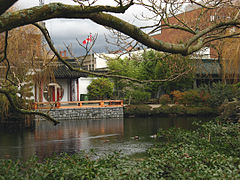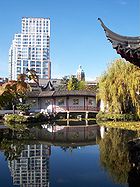- Dr. Sun Yat-Sen Classical Chinese Garden
-
Dr. Sun Yat-Sen Classical Chinese Garden 
Dr. Sun Yat-Sen Garden in winterType Non-profit charity Location Vancouver, British Columbia Area 0.3 acres (0.12 ha) Created 1986 The Dr. Sun Yat-Sen Classical Chinese Garden is the first full-size Chinese or "scholars" garden built outside of China, and is located in Chinatown in Vancouver, British Columbia, Canada. It is located at 578 Carrall Street and consists of a freely accessible public park and a garden with an admission fee. The mandate of the garden is to “maintain and enhance the bridge of understanding between Chinese and western cultures, promote Chinese culture generally and be an integral part of the local community.”[1]
History
The garden was built in 1985-1986. The outer park was designed by architects Joe Wai and Donald Vaughan, while the inner garden was conceived by Wang Zu-Xin as the chief architect, with the help of experts from the Landscape Architecture Company of Suzhou, China. Funding for the project came from the Chinese and Canadian governments, the local Chinese community, and other public and private sector sources, and it opened on April 24, 1986, in time for Expo 86.[1]
Because the climate in Vancouver is similar to that of Suzhou, many of the same plant varieties are found in the garden as in its Suzhou counterparts. The plants were chosen according to their blossom schedules in order to emphasize seasonal changes, especially the “awakening” in spring. They are also selected to invoke the symbolic, historical, and literary meaning of each plant and are used sparingly, in contrast to western gardens, and provide colour through all the seasons.[1]
Classical Chinese gardens employ philosophical principles of Feng Shui and Taoism, striving to achieve harmony and a balance of opposites. Craggy rocks, for example, are juxtaposed against delicate foliage. Water is also an important element of the garden, and the large pond offers stillness, sound, a reflection of the sky, and helps to unify the other elements. Fish and turtles live in the garden and also serve a symbolic purpose. Bats, dragons, and phoenixes are represented in objects throughout the garden. Numerous large rocks are strategically placed and are intended to represent mountains concealing and revealing park elements.[1]
The garden is named in honour of Dr. Sun Yat-Sen, a nationalist leader who is considered the “father of modern China.” The attribution is not arbitrary, as it emphasizes his connection with Vancouver. While traveling the world to raise awareness of, and funding for, the Chinese nationalist movement, Sun Yat-Sen stayed in Vancouver on three different occasions for extended periods. At the time, there was a significant presence of Chinese nationalists in British Columbia, who helped finance the Xinhai Revolution that overthrew the Qing Dynasty in 1911. Sun Yat Sen subsequently became the first president of the Republic of China.[2]
Please note that the Dr. Sun Yat-Sen Park and Dr. Sun Yat-Sen Classical Chinese Garden are two separate entities, linked by the artificial pond. While the Dr. Sun Yat-Sen Classical Chinese Garden is all of the above, the Dr. Sun Yat-Sen Park is a public park built in a Chinese style, with mostly North American materials.
See also
- List of botanical gardens in Canada
- List of Chinese gardens
- Queen Elizabeth Park, British Columbia
- Urban parks in Canada
Notes
- ^ a b c d "About the Garden". http://www.vancouverchinesegarden.com/. Retrieved 2006-12-12.
- ^ Allan Rowe (2000) (PDF). The Surveillance of the Chinese in Canada during the Great War. MA thesis. Simon Fraser University. http://www.collectionscanada.ca/obj/s4/f2/dsk2/ftp01/MQ61490.pdf. Retrieved 2006-12-12.
Coordinates: 49°16′46″N 123°06′12″W / 49.279551°N 123.103416°W
Categories:- Culture of Vancouver
- Parks in Vancouver
- Tourism in Vancouver
- Sun Yat-sen
Wikimedia Foundation. 2010.


